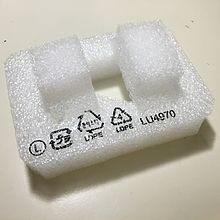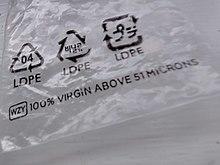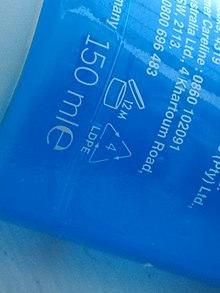
Low-density polyethylene (LDPE) is a thermoplastic made from the monomer ethylene. It was the first grade of polyethylene, produced in 1933 by Imperial Chemical Industries (ICI) using a high pressure process via free radical polymerization.[1] Its manufacture employs the same method today. The EPA estimates 5.7% of LDPE (recycling number 4) is recycled in the United States.[2] Despite competition from more modern polymers, LDPE continues to be an important plastic grade. In 2013 the worldwide LDPE market reached a volume of about US$33 billion.[3]
Properties
LDPE is defined by a density range of 917-930 kg/m3.[4] It is not reactive at room temperatures, except by strong oxidizing agents, and some solvents cause swelling. It can withstand temperatures of 80 °C continuously and 90 °C (194 °F) for a short time. Made in translucent or opaque variations, it is quite flexible and tough.
LDPE has more branching (on about 2% of the carbon atoms) than HDPE, so its intermolecular forces (instantaneous-dipole induced-dipole attraction) are weaker, its tensile strength is lower, and its resilience is higher. Also, because its molecules are less tightly packed and less crystalline due to the side branches, its density is lower.
When exposed to ambient solar radiation (consistent sunlight) the plastic produces significant amounts of two greenhouse gases - methane and ethylene. Due to its low density properties (high branching) it breaks down more easily over time compared to other plastics, leading to higher surface areas. Furthermore, production of these trace gases from virgin plastics increase with surface area/time, thus LDPE emits greenhouse gases at a more unsustainable rate compared to other plastics. At the end of a 212-day incubation, emissions have been recorded at 5.8 nmol g-1 d-1 of methane, 14.5 nmol g-1 d-1 of ethylene, 3.9 nmol g-1 d-1 of ethane and 9.7 nmol g-1 d-1 of propylene. When incubated in air LDPE emits methane and ethylene at rates ~2 times and ~76 times, respectively, more than in water.[5]
Chemical resistance
- Excellent resistance (no attack/no chemical reaction) to dilute and concentrated acids, alcohols, bases, and esters
- Good resistance (minor attack/very low chemical reactivity) to aldehydes, ketones, and vegetable oils
- Limited resistance (moderate attack/significant chemical reaction, suitable for short-term use only) to aliphatic and aromatic hydrocarbons, mineral oils, and oxidizing agents
- Poor resistance, and not recommended for use with halogenated hydrocarbons.[6]
Applications

LDPE is widely used for manufacturing various containers, dispensing bottles, wash bottles, tubing, plastic parts for computer components, and various molded laboratory equipment. Its most common use is in plastic bags. Other products made from it include:
- Trays and general purpose containers
- Corrosion-resistant work surfaces
- Parts that need to be weldable and machinable
- Parts that require flexibility, for which it serves very well
- Very soft and pliable parts such as snap-on lids
- Six pack rings
- Juice and milk cartons are made of liquid packaging board, a laminate of paperboard and LDPE (as the waterproof inner and outer layer), and often with of a layer of aluminum foil (thus becoming aseptic packaging).[7][8]
- Packaging for computer hardware, such as hard disk drives, screen cards, and optical disc drives
- Playground slides
- Plastic wraps
See also
- Linear low-density polyethylene (LLDPE)
- High-density polyethylene (HDPE)
- Medium-density polyethylene (MDPE)
- Ultra-high-molecular-weight polyethylene (UHMWPE)
- Polyethylene terephthalate (PET/PETE)
- Stretch wrap
References
- ^ Dennis Malpass (2010). Introduction to Industrial Polyethylene: Properties, Catalysts, and Processes. John Wiley and Sons. pp. 1–. ISBN 978-0-470-62598-9.
- ^ "Municipal Solid Waste Generation,n word and Disposal in the United States" (PDF). EPA.gov.
- ^ "Market Study: Polyethylene LDPE (2nd edition)". Ceresana.
- ^ BPF. "Polyethylene (Low Density) LDPE, LLDPE". www.bpf.co.uk. Retrieved 2018-06-14.
- ^ Karl, David M.; Wilson, Samuel T.; Ferrón, Sara; Royer, Sarah-Jeanne (1 August 2018). "Production of methane and ethylene from plastic in the environment". PLOS ONE. 13 (8): e0200574. doi:10.1371/journal.pone.0200574. ISSN 1932-6203. PMC 6070199. PMID 30067755.
 Material was copied from this source, which is available under a Creative Commons Attribution 4.0 International License.
Material was copied from this source, which is available under a Creative Commons Attribution 4.0 International License. - ^ "LDPE Chemical Compatibility Chart". CP Lab Safety.
- ^ LDPE products and applications. Exxon Mobil Corporation
- ^ DOW LDPE 5004I. IDES – The Plastics Web
External links
 Media related to Low-density polyethylene at Wikimedia Commons
Media related to Low-density polyethylene at Wikimedia Commons- 2010_MSW_Tables_and_Figures_508.pdf. epa.gov

_bowl%2c_by_GEECO%2c_Made_in_England%2c_c1950.jpg)

